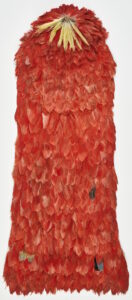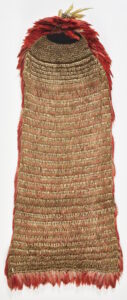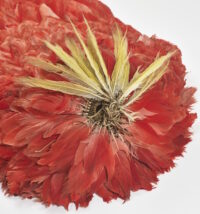 The National Museum of Denmark has donated its most exceptional 17th century Brazilian feather cape to the new National Museum of Brazil to help rebuild the museum’s patrimony after its entire ethnographic collection of 20 million irreplaceable artifacts was destroyed in a fire in 2018. Interestingly, the iconic scarlet ibis feather cape was not among them, as the few surviving examples known were all in European museums.
The National Museum of Denmark has donated its most exceptional 17th century Brazilian feather cape to the new National Museum of Brazil to help rebuild the museum’s patrimony after its entire ethnographic collection of 20 million irreplaceable artifacts was destroyed in a fire in 2018. Interestingly, the iconic scarlet ibis feather cape was not among them, as the few surviving examples known were all in European museums.
Made by hand-tying scarlet ibis and macaw feathers to a woven cotton net, the cape dates to the early 1600s and was crafted by the Tupinambá people of Brazil. The Tupinambá were the first indigenous people the Portuguese encountered when they reached eastern Brazil in 1500. European chroniclers record that the Tupinambá were adept feather workers and used local bird feathers in jewelry, sashes, headbands, cloaks, even as tattoo needles. Used in important rituals and ceremonies, the scarlet ibis cloaks were revered for their beauty and religious significance.
 The Tupinambá were described as taking painstaking care of their feathered items, handling them with kid gloves to prevent deterioration. They were not so gingerly handled by the Portuguese, Spanish and by the functionaries of the Dutch West India Company which occupied parts of northeast Brazil between 1624 and 1654. The striking feathered cloaks made their way into the collections of the European monarchs and other wealthy collectors, but few were able to survive the centuries.
The Tupinambá were described as taking painstaking care of their feathered items, handling them with kid gloves to prevent deterioration. They were not so gingerly handled by the Portuguese, Spanish and by the functionaries of the Dutch West India Company which occupied parts of northeast Brazil between 1624 and 1654. The striking feathered cloaks made their way into the collections of the European monarchs and other wealthy collectors, but few were able to survive the centuries.
Today only 11 Tupinambá feather capes are known to survive, several of which are also owned by the National Museum of Denmark. The recently-donated cloak is the best preserved of all of them. Compare it to the cloak at the Pinacoteca Ambrosiana in Milan to see how much denser the feather coverage is and how pristine each individual feather still looks. It even retains the small hood made of yellow macaw feathers, long since lost from the Ambrosiana example.
 The Tupinambá population plummeted after their encounter with European pathogens, but the tradition of feather work never stopped. Today there are around 4,600 recognized Tupinambá in Brazil and their leaders have been working with officials from the National Museum in Rio to negotiate the return of the sacred feather cape from Copenhagen.
The Tupinambá population plummeted after their encounter with European pathogens, but the tradition of feather work never stopped. Today there are around 4,600 recognized Tupinambá in Brazil and their leaders have been working with officials from the National Museum in Rio to negotiate the return of the sacred feather cape from Copenhagen.
Upon receiving the letter from Dr. Rane Willerslev, Director of the National Museum of Denmark, chief Tupinambá Babau said: “For us, the donation of the Tupinambá mantle means the return of an ancestor! It is also the return of hope that never dies: a concrete answer for those who believe in the strength of their people and continue to fight for their culture, secrets and religion. We continue to create other mantles. But now, by a generous donation, our greatest relic will return to Brazil! The bird that symbolizes this mantle, the ibis, which no longer exists in our region, is born and grows gray. When eating crabs, their feathers turn red. It is a sign of transformation that occurs in everything, human beings and their culture. Many thanks to the National Museum of Brazil and Denmark for allowing us to hear the sacred words of our ancestors again. The Cloak is back!”
The Museu Nacional is in the process of rebuilding its ethnographic archives and physical collections in close collaboration with the country’s indigenous peoples and museums outside Brazil. The National Museum of Denmark and a number of other European museums are already supporting the reconstruction by creating digital catalogues that will make Brazilian artefacts and archive material located in European museums available. […]
“The feather cape has had a prominent place in our collection, but it has greater significance for the Brazilian population as a cultural symbol, as a material heritage of the Tupinambá and as evidence of Brazilian-European historical, colonial encounters. In Brazil, it will be available to the indigenous peoples who have a strong historical and cultural connection to it,” says Christian Sune Pedersen, head of research.
The cape will remain in Copenhagen long enough to be photographed in high resolution and analyzed to determine its age, origin and exact composition. Meanwhile, the National Museum of Brazil will focus on creating an ideal setting for the long-term conservation and display of the cape.
One of my former teachers is a relative of botanist C. F. Philipp Martius, who in 1817 together with physician and biologist Johann Baptist Spix –both from Franconia– was sent to Brazil by Maximilian I Joseph, the king of Bavaria.
Martius seemingly published on everything, even on the Tupinambá people 😀
First published in: 1867:”Das Volk der Tupi, Tupis, Tupinambá, Tupinambazes, Guarani oder Cari”, Published online by Cambridge University Press 29 August 2010. / “The people of the Tupi, Tupis, Tupinambá, Tupinambazes, Guarani or Cari” (Martius)
SUMMARY (machine translated):
——-
“That the Tupi were a powerful nation in Brazil and that besides them only a second hostile one, the Tapuya, existed, is a view that is often spread in the country itself. Both need to be corrected. There is no doubt that at the time of the Conquista several nationalities shared the possession of the great country, and there was no nation of Tapuya, but the Tupis and their befriended Portuguese called all hostile tribes by that name. We must remember this relationship, which has already been mentioned (p. 50), by emphasizing that the Tupis were the most widespread and predominant people at the time of the discovery. But we are not justified in considering them the first autochthons of the country. They are only the starting point for an investigation, behind which the original state is lost in deepest darkness. And even their later history can be sketched only in imperfect outlines.
Already with the name of this people we meet the most manifold opinions. According to Vasconcellos, Tupi was a place from where the Tupis had come and from which they had taken the name. The large number of patronymicis in other languages, which can be referred back to the name of a place, would speak for such an assumption. The same writer, however, derives the name Tobajaras, Tobayaras, Toba-uara, which, after the so frequently occurring confusion of vowels and consonants, could also be regarded as synonymous with Tupyaras, from Tobá, face, and Jara, Yara, Uara, [meaning] lord, man, warrior, because the nation of the Tupi would have had the land on the sea, as it were the face of the continent.”
——-
Returning artifacts to the country of their origin is an act in worldbuilding. Such artifacts fit better in their original socio-cultural ecosystem.